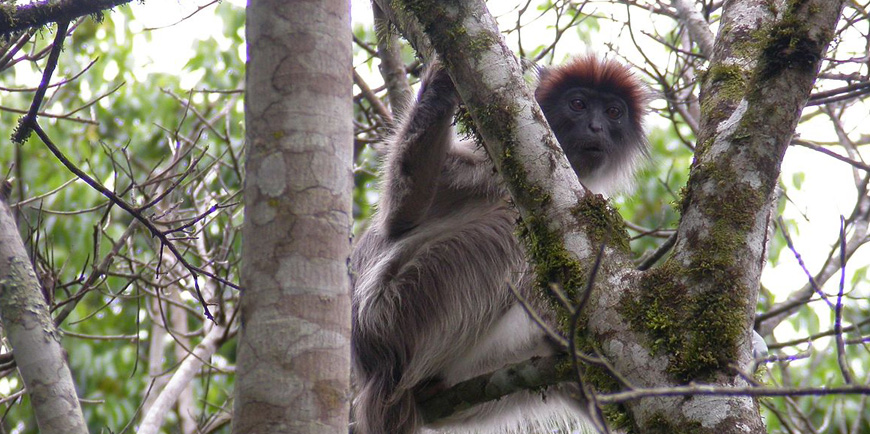
Kibale National Park contains one of the loveliest and most varied tracts of tropical forest in Uganda. Forest cover, interspersed with patches of grassland and swamp, dominates the northern and central parts of the park on an elevated plateau.
The park is home to a total of 70 mammal species, most famously 13 species of primate including the chimpanzee.
It also contains over 375 species of birds. Kibale adjoins Queen Elizabeth National Park to the south to create a 180km-long corridor for wildlife between Ishasha, the remote southern sector of Queen Elizabeth National Park, and Sebitoli in the north of Kibale National Park.
The Kibale-Fort Portal area is one of Uganda’s most rewarding destinations to explore. The park lies close to the tranquil Ndali-Kasenda crater area and within half a day’s drive of the Queen Elizabeth, Rwenzori Mountains and Semuliki National Parks, as well as the Toro-Semliki Wildlife Reserve.
Geography and Climate
Kibale National Park is located in the districts of Kabarole and Kamwenge, approximately 320 kilometres, by road, west of Kampala, Uganda’s capital and largest city. Fort Portal in Kabarole District is the nearest large city to the national park. The geology consists of rocks formed in the Precambrian period which are sedentary, strongly folded and metamorphosed. The Toro system overlaying these rocks forms prominent ridges of quartzite and sometimes schists and phyllites, which are intruded by amphibiolites, gneiss and granites. Some hills have layers of hard laterite exposed on them. About 90% of the Park is overlain by red ferralitic soils of which 70% are sandy clay loams in the North and 30% are clay loams in the South. These soils are deeply weathered, show little differentiation in horizon and are of very low to moderate fertility. The remaining 10% is where fertile eutrophic soil occurs on a base of volcanic ash limited to Mpokya and Isunga areas on the western edge of the park.
The park has a tropical type of climate with two rainy periods, March to May and September to November. The annual mean temperature range rises from 14° – 15°C, – minimum to 26° – 27°C maximum. The annual rainfall is 1,100 – 1,600 mm. There is a pronounced dry season in December to February. Rain falls more in the North than in the South.
Biodiversity
The forest cover in Kibale National Park is broadly classified into three. It is mid-altitude, moist evergreen in the north, gradually decreasing in elevation to moist semi-deciduous in the south and a mixture of deciduous and evergreens in the central parts.
Kibale National Forest has one of the highest diversity and concentration of primates in Africa. It is home to a large number of endangered chimpanzees, as well as the red colobus monkey considered Endangered and the rare L’Hoest’s monkey that are considered Vulnerable. The park is also home to over 325 species of birds, 4 wild fellids, 13 species of primates, a total of at least 70 other species of mammals, and over 250 tree species.
There are 13 species of primates in Kibale National Park. The park protects several well-studied habituated communities of common chimpanzee, as well as several species of Central African monkey including the Uganda mangabey (Lophocebus ugandae), the Ugandan red colobus (Procolobus tephrosceles) and the L’Hoest’s monkey. Other primates that are found in the park include the black-and-white colobus (Colobus guereza) and the blue monkey (Cercopithecus mitis). The park’s population of elephants travels between the park and Queen Elizabeth National Park. Other terrestrial mammals that are found within Kibale National Park include red and blue duikers, bushbucks, sitatungas, bushpigs, giant forest hogs, warthogs, and buffalo. The carnivores that are present include leopards, african golden cats, servals, different mongooses and two species of otter. In addition, lions visit the park on occasion.
Bird life in the park is so prolific, boasting over 375 sited species of birds, including the western green tinker bird, olive long-tailed cuckoo, two species of pittas (African and green-breasted) and the African grey parrot, Imperative to note that the ground thrush (Turdus kibalensis) is endemic to Kibale National Park.
The park boast over 229 species of trees found within the moist tropical forests of the park. Some endangered timber species of trees include; Lovoa swynnertonnii, Cordia millenii, and Entandrophragma angolense. The forest understory is dominated by shade-tolerant shrubs and herbs, which include Palisota schweinfurthii and Pollia condensata, in addition to ferns and broad leaf grasses.
Flora
There are approximately 229 species of trees found within the moist tropical forests of the park. Some endangered timber species of trees include Cordia millenii, Entandrophragma angolense, and Lovoa swynnertonnii. The forest understory is dominated by shade-tolerant shrubs and herbs, which include Palisota schweinfurthii and Pollia condensata, in addition to ferns and broad leaf grasses.
Forestry research in the Park
Many studies have been conducted within the park to assess the factors influencing forest regeneration and forest management techniques. One such study’s results suggested that forest restoration could be achieved through preventing fires within the park and allowing natural succession to occur so that the grasslands formed due to human activity could naturally regenerate to forests. The results showed that plots within the park that had the longest history of fire exclusion had the highest species diversity of trees. Furthermore, species of trees that required animal dispersal of their seeds were far more abundant than non-animal dispersed species in the plot with the longest duration of fire exclusion. This suggests that seed dispersing animals were also more abundant in areas where fire was excluded. Lastly, the presence of seed dispersers and animal dispersed species of trees in some grassland plots suggest that suppressing fire and allowing natural seed dispersal to occur can encourage forest regeneration. Another study evaluated the use of exotic pine and cypress tree plantations as a forest restoration technique within the park. This study showed a high level of natural regeneration of indigenous trees within pine plantations most likely due to the use of these plantations by seed dispersing animals such as redtail monkeys, chimpanzees, duikers, and bushpigs, all of which were sited or tracked within the plantations. A recent study conducted by Ireland, Cheng and Bischoff investigated the long-term impacts of logging on ant genus richness in Kibale National Park.[citation needed]Interestingly, the authors found evidence suggesting that invertebrate communities can recover; however Kibale National Park is at threat of becoming the epicentre of the invasive Argentine Ant (Linepithema humile).
Wild coffee project
Robusta coffee grows natively in the Kibale forest area. From 1999 to 2002 an effort was made to commercialize this coffee as a premium consumer brand, emulating and extending the success of shade grown in Central America. Revenue from the coffee production was intended to finance conservation management activities.
Initial funding for project development came from USAID. The project was implemented with funding from the Ford Foundation and $750,000 from the World Bank Global Environment Facility. The project had initial success in setting up local production standards and procedures and control infrastructure. Initially it was led by the Uganda Coffee Trade Federation, until the independent US-based non-profit Kibale Forest Foundation was created to take over the project. Sustainable annual yield was estimated at 1,500 pounds (680 kg). Organic certification was delivered by the Swedish KRAV labeling firm. It was subsequently discovered that there was no demand for the product, as the robusta variety is perceived as inferior to arabica coffee typically demanded by the premium market. Various blending schemes were turned down by coffee distributors. Project leaders estimated that $800000 in marketing expenditure would be required to create demand.

